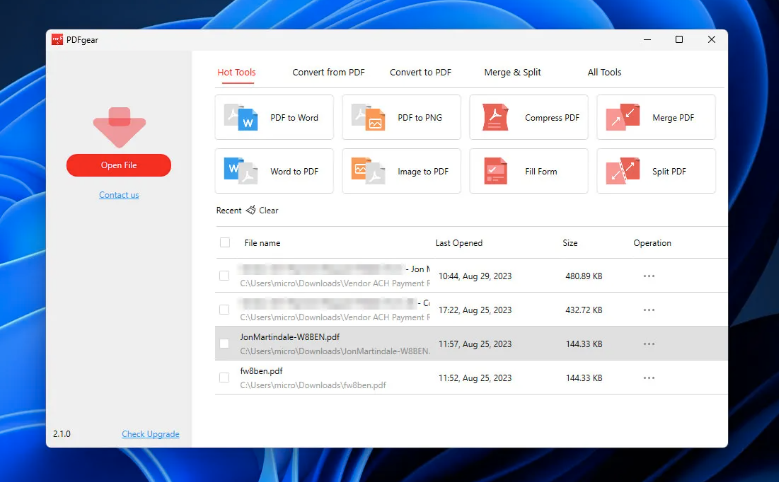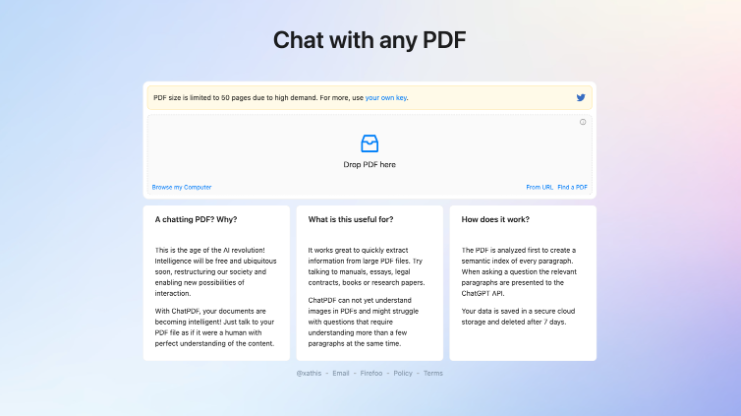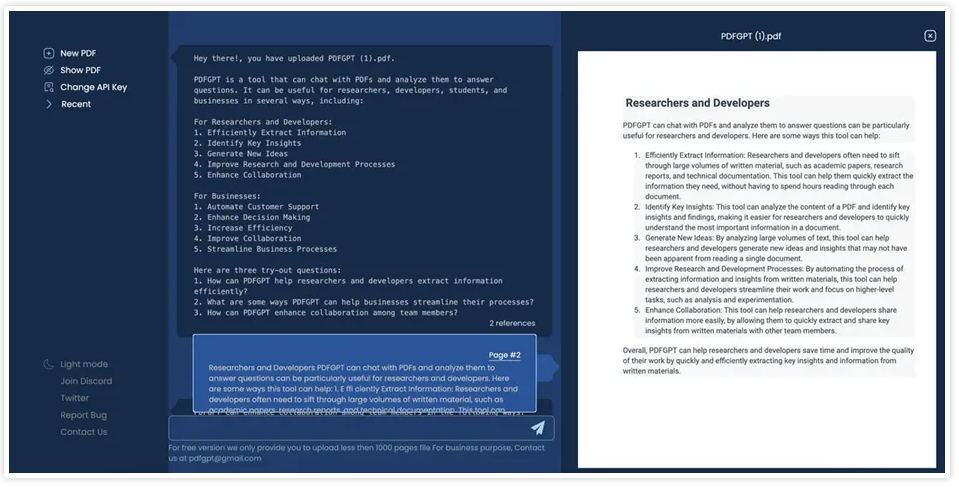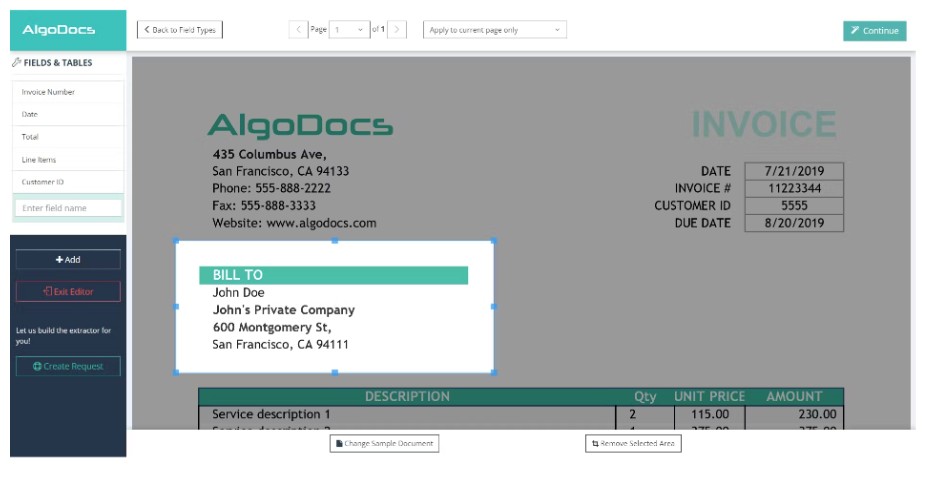AI PDF readers represent a significant leap from traditional PDF software. These tools not only allow users to view and interact with PDF documents but also leverage artificial intelligence to offer enhanced functionalities like summarization, conversion, translation, and even answering queries related to the content. This integration of AI into PDF readers is transforming how we interact with digital documents.
The 6 Best AI PDF Readers
When comparing these AI PDF readers, it’s important to consider factors like pricing, the range of features, user interface, and specific needs like summarization or text-to-speech.
| AI PDF Reader | Pricing | System | AI Features | OCR Feature | Other Features |
|---|---|---|---|---|---|
| PDFgear | Free | Online | AI summarizer, PDF editing, prompt-based interaction | No | PDF merging, PDF conversion |
| ChatPDF | $60/year (Plus version) | Online | GPT 3.5 integration, interactive Q&A | No | Multilingual support, document management |
| Foxit Reader | $139/year (PDF Editor Suite) | Windows, macOS, iOS, Android, Online | AI redaction, educational AI, NLP | Limited | Digital signature, secure cloud sharing |
| PDFGPT.IO | $9.99 to $49.99/month | Online | Real-time query responses, efficient summarization | No | User-friendly interface, customizable summarization |
| LightPDF | $5/month (annual) or $19.99/month (monthly) | Online | AI chatbots | Yes | Editing, annotating, converting PDFs |
| AlgoDocs | $23 to $175/month | Online | AI-driven data extraction | Yes (Advanced) | High accuracy in data extraction |
1. PDFgear

PDFgear stands as a highly versatile and user-centric AI PDF reader, catering especially to those who handle extensive PDF documents. Its integration with the latest AI technologies enables users to perform a variety of tasks beyond basic reading, such as summarizing complex documents, converting PDFs, and merging multiple files into one.
The tool’s strength lies in its ability to process large volumes of text, making it ideal for handling academic papers, legal documents, and research reports. It simplifies the process of extracting key information from dense materials, thereby enhancing productivity and comprehension. Moreover, its commitment to privacy, as evidenced by its policy of not retaining user data, makes it a trustworthy option for handling sensitive documents. The fact that it offers these advanced features at no cost further adds to its appeal, providing a potent combination of functionality and accessibility.
- Pros: Completely free, privacy-focused (no data retention), multiple functionalities beyond just reading.
- Cons: Limited to PDF-related tasks, may lack advanced editing features found in paid tools.
2. ChatPDF

ChatPDF leverages the power of OpenAI’s GPT 3.5, offering an interactive and intelligent platform for engaging with PDF documents. It is particularly adept at enhancing the learning experience, providing users with the ability to delve deep into their PDFs and extract specific information as needed. This tool is particularly beneficial for students and professionals who need to analyze and understand complex texts, such as textbooks, research papers, and technical documents.
ChatPDF’s ability to handle queries in multiple languages broadens its appeal to a global user base. Additionally, its user-friendly design facilitates easy document management, including sharing, renaming, and exporting features. However, the tool’s sophistication can occasionally lead to overly detailed responses, which may require users to refine their queries for more concise information. The annual subscription model makes it a cost-effective solution for those seeking an AI-enhanced reading experience.
- Pros: Great for academic use, secure sharing, allows for extensive interaction with PDF content.
- Cons: Sometimes may generate overly detailed responses, and the AI might misinterpret complex queries.
3. Foxit Reader

Foxit Reader has established itself as a formidable player in the PDF software arena, renowned for its speed and array of features bolstered by AI technology. The tool is a boon for knowledge workers, offering functionalities that go beyond mere reading to include document editing, e-signatures, and secure sharing. Foxit Reader’s AI capabilities, such as its AI redact tool and educational AI, are tailored to improve productivity and document handling efficiency.
The software’s ability to process documents quickly and its emphasis on security, including encryption and digital signature functions, make it a reliable choice for businesses and professionals handling confidential information. Despite its many strengths, Foxit Reader’s less advanced OCR (Optical Character Recognition) technology might be a limitation for those who require precise text recognition from scanned documents. The pricing, although reflective of its professional-grade features, might be a consideration for individual users or small businesses.
- Pros: Fast processing, comprehensive document security features, digital signature functionality.
- Cons: Limited OCR capabilities, the full range of AI features available only in the paid version.
4. PDFGPT.IO

PDFGPT.IO is distinguished by its focus on providing real-time, accurate responses to queries extracted from PDF documents. Utilizing cutting-edge AI algorithms, it excels at summarizing complex documents, making it a valuable asset for users who deal with extensive research papers, lengthy client requirements, or detailed study materials. Its interface is designed for ease of use, allowing for straightforward uploading and downloading of documents.
PDFGPT.IO’s customizable options for summarization enable users to tailor the output to their specific needs, ensuring that the most relevant information is highlighted. While the tool is highly efficient in delivering concise summaries and rapid responses, access to its full suite of features comes at a cost, with various subscription plans catering to different user needs. This might be a consideration for those who require frequent and advanced usage of such AI functionalities in their daily document handling tasks.
- Pros: Suitable for handling complex PDFs, offers accurate and fast answers, simple upload and download process.
- Cons: Access to full features requires a paid subscription.
5. LightPDF

LightPDF is an all-encompassing tool that extends beyond typical PDF reading to include a wide array of functionalities such as conversion, editing, OCR, and interaction with AI chatbots. Its strength lies in its comprehensive set of tools, making it a one-stop solution for various PDF-related tasks. Users can enjoy the convenience of editing, annotating, and converting PDFs within a single platform. LightPDF’s integration of AI chatbots for interactive reading adds an innovative dimension, allowing users to engage with their documents in a more dynamic manner.
The cloud support feature enables file sharing and collaborative work, enhancing its utility for team projects and remote work scenarios. Despite its robust toolset, LightPDF may face some limitations in its online mode, particularly in scenarios where a stable internet connection is not available. The tool’s pricing structure, with monthly and annual options, offers flexibility to accommodate different user preferences and budgets.
- Pros: Extensive toolset for PDF manipulation, easy to use, cloud and mobile accessibility.
- Cons: Some limitations in online functionality, may require a stable internet connection for best performance.
6. AlgoDocs

AlgoDocs specializes in AI-driven data extraction from PDFs and images, positioning itself uniquely among AI PDF readers. It primarily serves as a data extraction platform rather than a conventional PDF reader, making it highly suitable for businesses and individuals who need to mine specific information from documents. AlgoDocs integrates advanced OCR and Image Processing technologies into its algorithms, ensuring high accuracy in data extraction. This capability is particularly beneficial for extracting data from structured documents like forms, tables, and invoices, facilitating efficient data processing and analysis.
The tool’s user-friendly interface and reliable performance are complemented by robust customer support, enhancing the overall user experience. While AlgoDocs excels in data extraction, its focus on this specific functionality means it might not cater to users looking for more traditional PDF reading and editing capabilities. The pricing tiers offer various options catering to different scales of data extraction needs.
- Pros: High accuracy in data extraction, great customer support, user-friendly interface.
- Cons: Primarily focused on data extraction, less on reading or summarization.
The Benefits of Using AI PDF Readers
AI PDF readers have revolutionized the way we interact with digital documents, offering a plethora of advantages that cater to a wide array of user needs. Here are some of the key benefits, extending the overview to provide a more comprehensive understanding:
- Enhanced Efficiency and Productivity: One of the most significant benefits of AI PDF readers is their ability to dramatically increase efficiency. With features like automatic summarization and rapid information retrieval, these tools can save countless hours that would otherwise be spent sifting through extensive documents. This is particularly beneficial in academic and professional settings where time is often of the essence.
- Improved Accessibility and Inclusivity: AI PDF readers often come with text-to-speech capabilities, making documents more accessible to individuals with visual impairments or reading difficulties. This inclusivity extends the reach of digital content to a broader audience, ensuring that everyone has equal access to information.
- Advanced Interactivity and Engagement: The integration of AI allows for a more interactive experience with PDFs. Users can ask questions and get contextual answers, making the reading experience more engaging and informative. This feature is especially useful for students and professionals who need to delve deeper into the content for better understanding or research purposes.
- Customizable Learning and Reading Experience: AI PDF readers often offer customizable settings to cater to different learning styles and preferences. Whether it’s adjusting the speed of text-to-speech or translating content into different languages, these tools can be tailored to suit individual needs, enhancing the overall reading experience.
- Document Management and Organization: Beyond reading, many AI PDF readers provide functionalities for editing, annotating, organizing, and even converting documents. This multifunctionality turns them into comprehensive tools for document management, streamlining workflows and improving organization.
- Innovative Features and Continuous Improvement: As AI technology evolves, these PDF readers continuously integrate innovative features, staying at the forefront of technological advancements. This ensures that users are always equipped with the latest tools to enhance their document interaction experience.
In summary, AI PDF readers not only simplify the way we work with PDFs but also add layers of interactivity, accessibility, and efficiency, transforming them into indispensable tools in our digital toolkit.
Conclusion: Embracing the Future with AI PDF Readers
As we have seen, each AI PDF reader has its unique set of features and strengths. When choosing the right one for you, consider what aspects of your PDF interaction you wish to enhance. Do you need efficient summarization for quick comprehension, or is accessibility your primary concern? Are you looking for advanced editing and organizational tools, or do interactive features take precedence? Answering these questions will guide you towards the AI PDF reader that best fits your needs.
In conclusion, embracing AI PDF readers is not just about keeping up with technology; it’s about unlocking new potentials in how we handle information. These tools offer a smarter, more efficient, and inclusive way to interact with PDFs, positioning themselves as essential assets in our digital toolkits. So, explore the possibilities, choose the reader that aligns with your needs, and step into a new era of document management and interaction.
FAQs on Choosing the AI PDF Reader
What Makes an AI PDF Reader Different from a Standard PDF Reader?
AI PDF Readers integrate artificial intelligence to provide advanced functionalities beyond basic viewing and editing. These include text summarization, interactive Q&A based on document content, text-to-speech conversion, language translation, and enhanced search capabilities. The AI component significantly enhances efficiency, accessibility, and interactivity compared to standard PDF readers.
Can AI PDF Readers Translate Documents into Different Languages?
Yes, many AI PDF readers are equipped with language translation features. They use AI algorithms to translate the text within PDF documents into various languages, making it easier for users to understand content in their preferred language.
Are AI PDF Readers Useful for Academic Research?
Absolutely. AI PDF readers are particularly beneficial for academic research. They can summarize lengthy scholarly articles, respond to queries about the content, and help in organizing research materials efficiently. This can save researchers a significant amount of time and effort in digesting and analyzing large volumes of academic literature.
How Do AI PDF Readers Enhance Accessibility?
AI PDF readers enhance accessibility primarily through text-to-speech features, allowing visually impaired users or those with reading difficulties to listen to the content of PDF files. Some also offer adjustable reading settings and language translation, making documents accessible to a wider audience with diverse needs.
What Should I Consider When Choosing an AI PDF Reader?
When choosing an AI PDF reader, consider factors such as the specific AI features offered (like summarization, text-to-speech, translation), compatibility with your operating system, the tool’s ease of use, and pricing. Also, consider whether the reader has OCR capabilities for handling scanned documents and the level of customer support provided.


![[SOlVED]Fix the Error of “System UI Isn’t Responding” on Android](https://www.techviewsolution.com/wp-content/uploads/2024/03/fix-system-ui-isnt-responding-error-on-android.png)

![How to Unsync iPhone From iPad [100% solved]](https://www.techviewsolution.com/wp-content/uploads/2024/03/unsync-iphone-from-ipad.png)
